The Georgia Department of Natural Resources state’s that Georgia is home to 46 species of snakes. Luckily, of this number, only 6 are venomous. Georgia’s venomous snakes aren’t fond of company and are less likely to be seen than nonvenomous and harmless snakes.
However, it is not impossible to spot them, so it’s a good idea to be prepared. Let’s take a look at 6 snakes to watch out for near Atlanta, Georgia. Three of them are extremely deadly!
6 Venomous Snakes in Atlanta, Georgia
The six species of venomous snakes found in Georgia are cottonmouths, copperheads, eastern diamondback rattlesnakes, timber rattlesnakes, pygmy rattlesnakes, and coral snakes.
Cottonmouths (Agkistrodon piscivorus)
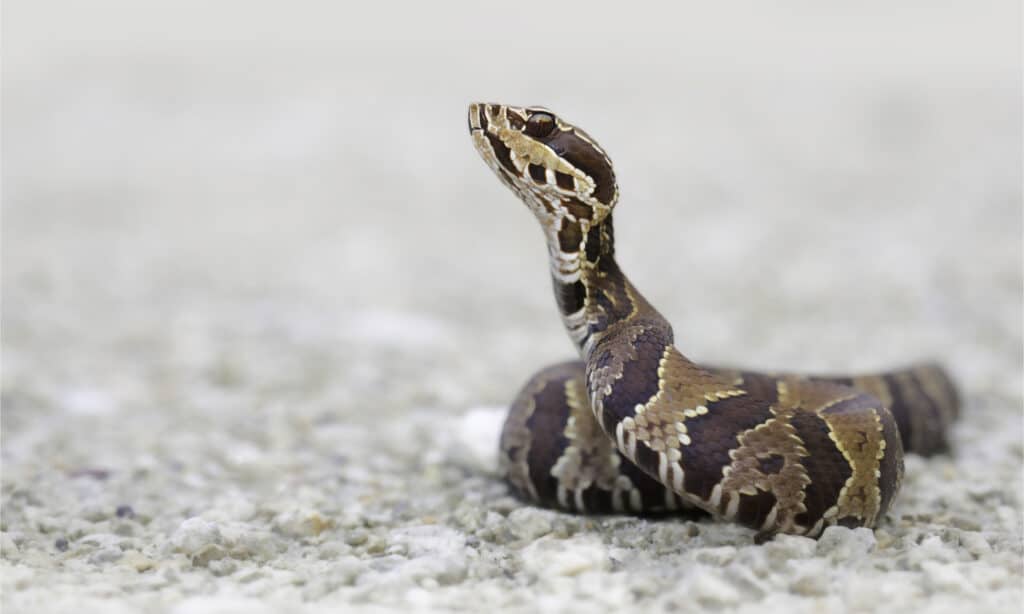
Cottonmouths are semi-aquatic snakes found in several parts of West Atlanta, Georgia.
©Kristian Bell/Shutterstock.com
Cottonmouths are medium-sized semi-aquatic snakes found in several parts of West Atlanta measuring from 26 to 35 inches. These snakes are usually black-colored with markings over their body and head. They also have crossbands across their whole bodies.
Also called aquatic moccasins, these snakes have hemotoxic venom that breaks down blood cells and stops clotting, making it easier for the victim to bleed. Cottonmouth’s maximum venom yield is 237 mg and since their human lethal dose is about 100–150 mg, they are theoretically strong enough to kill 2 humans. Cottonmouths are also known to stand their ground against attackers. Luckily, they do not bite unless they feel threatened.
Eastern diamondback rattlesnakes (Crotalus adamanteus)
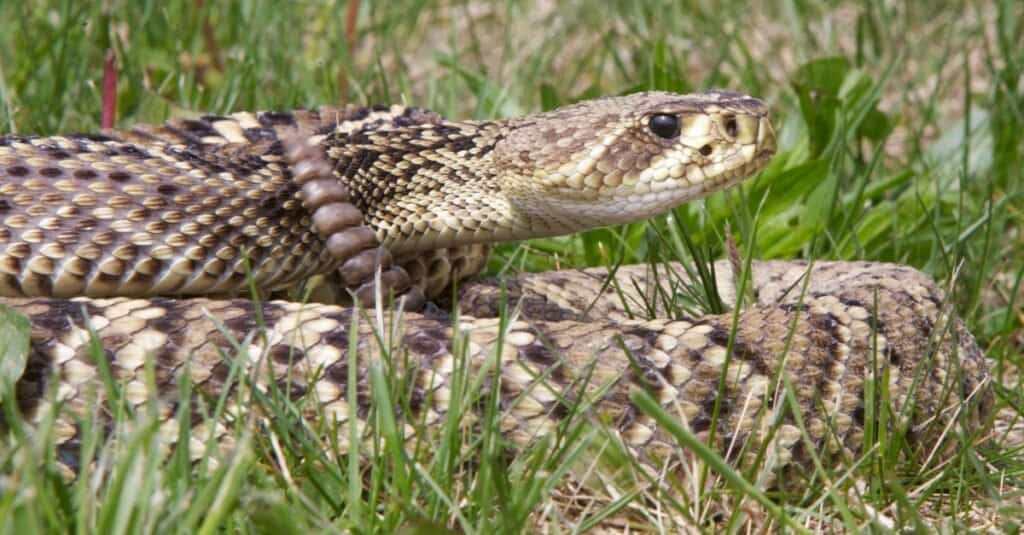
Eastern diamondback rattlesnakes are extremely venomous snakes found south of Coastal Plain’s Fall Line in Georgia.
©iStock.com/NajaShots
Eastern diamondback rattlesnakes are one of the deadliest pit vipers. Adults weigh four to five pounds and grow up to four to five feet long. These highly venomous snakes are known for their quick and extremely painful bites. Their venom contains high levels of hemotoxins that attack blood cells.
The eastern diamondback rattlesnake’s colors often range from blackish-gray to muddy gray and even olive green. This coloring makes it easy for them to hide in the wild and remain unseen. They also have keeled scales and irregular botches close to their heads. In Georgia, eastern diamondback rattlesnakes are found south of Coastal Plain’s Fall Line.
Timber rattlesnake (Crotalus horridus)
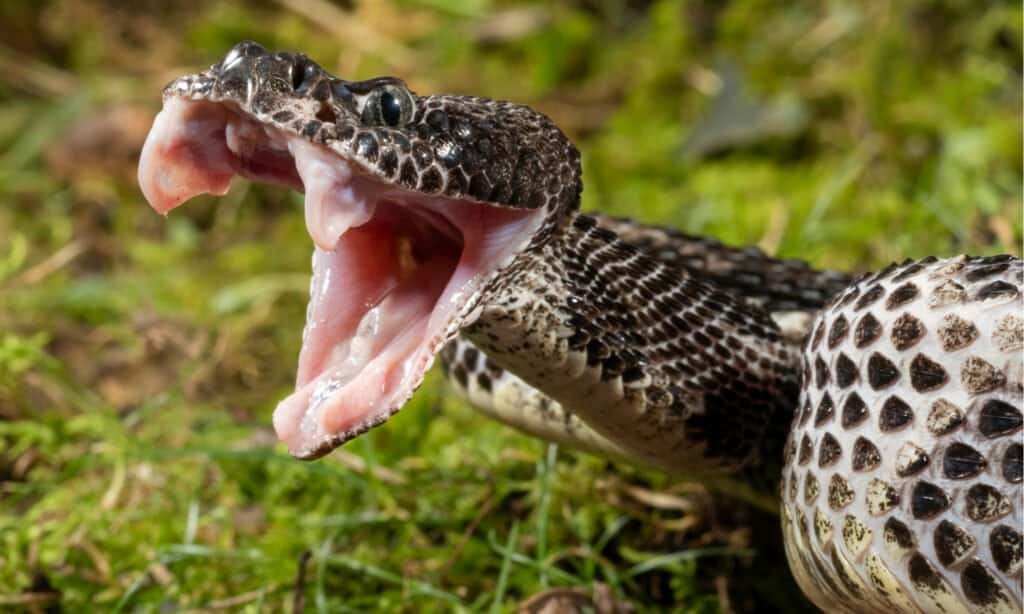
Timber rattlesnakes are endangered and venomous pit vipers also known as canebrake rattlesnakes.
©Joe McDonald/Shutterstock.com
Timber rattlesnakes are venomous pit vipers found in most parts of Georgia. They are endangered and venomous, making it illegal to own one in many states in America. Also known as canebrake rattlesnakes, they have rounded heads that are either gray, tan, or yellow. They also have V-shaped tails.
In humans, timber rattlesnake bites aren’t usually fatal- especially if the victim is treated properly and immediately. Their venom contains proteolytic toxins and hemotoxins which they usually use to break down tissue when eating prey.
Pygmy rattlesnake (Sistrurus miliarius)
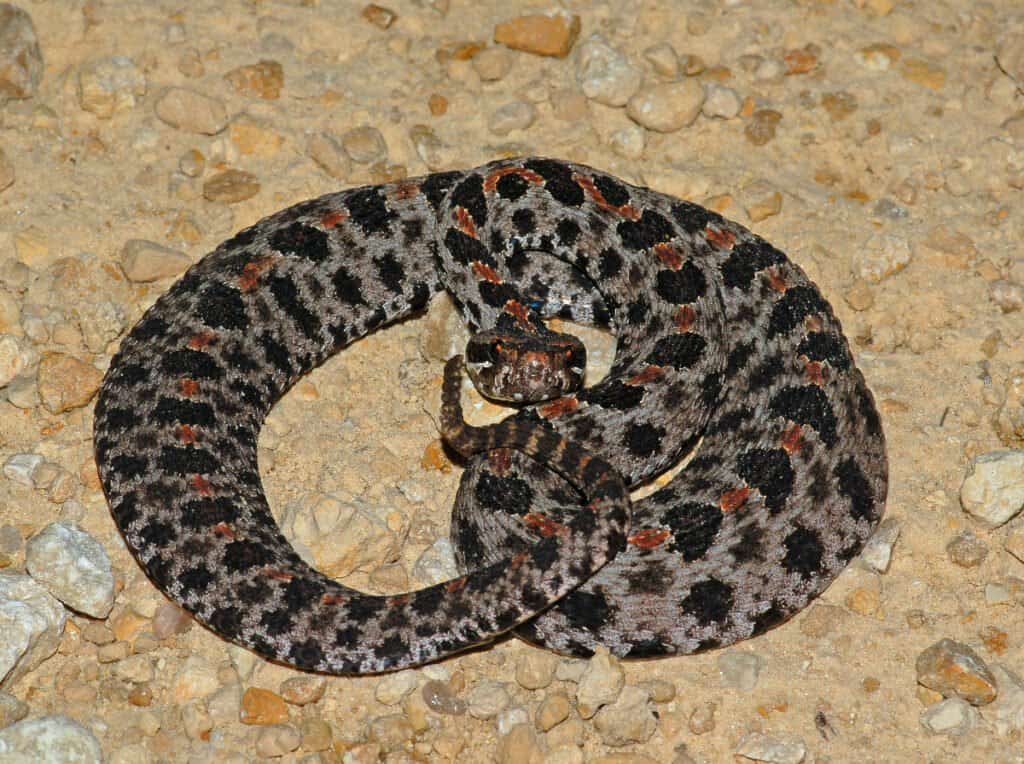
Pygmy rattlesnakes, also known as ground rattlesnakes, are the smallest venomous snakes in the United States and Georgia.
©Gerald A. DeBoer/Shutterstock.com
Pygmy rattlesnakes are also known as ground rattlesnakes. They are the smallest venomous snakes in the United States and Georgia. They are found in the state’s central, northwestern, and northeastern areas.
Pygmy rattlesnakes have thick bodies and dark markings through each eye. They also have circular spots that run down their backs. Usually, their scales are dark gray to black with orange or red dorsal stripes. Pygmy rattlesnakes are known for their painful bites. However, their venom is fatal to their prey but not usually to humans. They are known to prey on small mammals, lizards, and smaller snakes.
Coral Snakes (Micrurus)
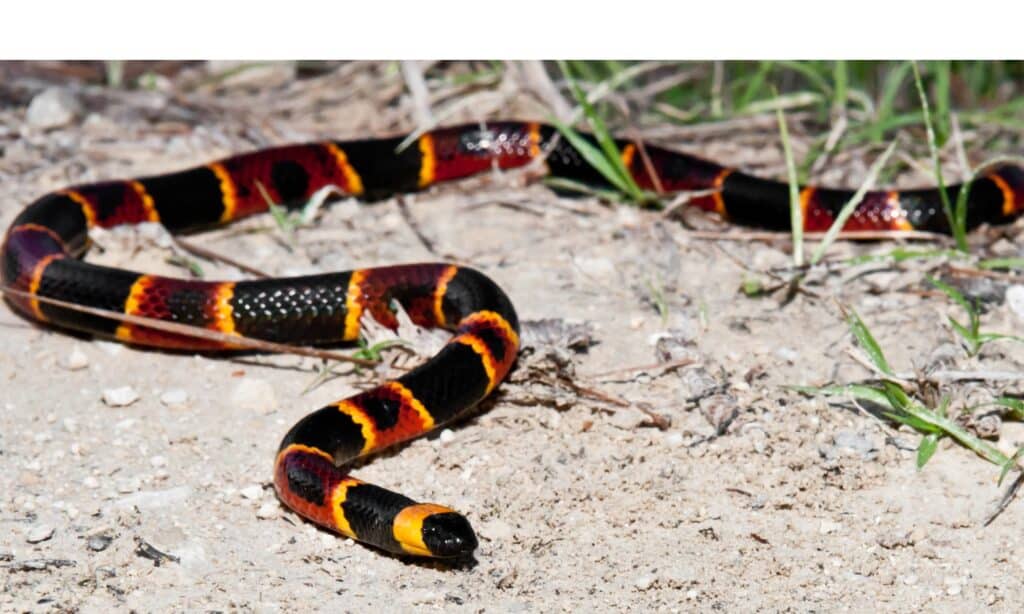
Coral snakes are elapids with venom that is theoretically strong enough to kill 5 humans.
©iStock.com/JasonOndreicka
Coral snakes are beautiful elapid snakes known for being elusive and brightly colored. They can be found in Georgia’s coastal plain and measure anywhere from 36 to 60 inches. Coral snakes are one of the most dangerous snakes found in Georgia. Their venom contains neurotoxins that cause paralysis and respiratory failure.
According to researchers, coral snakes have a maximum venom yield of 20 mg and a human lethal dose of 4-5 mg. Consequently, a coral snake has venom that is strong enough to kill 5 humans.
Eastern Copperhead (Agkistrodon contortrix)

Eastern copperheads are pit vipers found all around Georgia, except in the southeastern parts.
©Jeff W. Jarrett/Shutterstock.com
The eastern copperhead, commonly referred to as copperhead, is a venomous pit viper. They can be found all around Georgia, except in the southeastern parts. They are also found all over South America and are known to favor hidden locations, forests, woodlands, and swampy regions.
Copperheads are known for their extremely painful, but rarely fatal bites. When they come in contact with humans, they are known to freeze in hopes of not being seen. However, they are quick to bite if they feel threatened. Copperheads bite more Americans than any other snake.
When are Georgia’s Snakes Most Active?
Generally, snakes love warmer weather. Due to the warmer weather, snakes in Georgia are more active during the spring. However, the time of the day depends on their species. Copperheads, for example, are more active in the late afternoons and evenings. Snakes hibernate through winter and emerge in warmer weather.
What To Do If You Spot a Snake in Georgia
If you spot a snake in Georgia, it’s important to stay calm and avoid getting closer. The snake could be venomous and could strike if it feels threatened. You should exit the area as quickly as possible. Stay calm and walk away as quietly as you can.
Next, put a call through to Georgia’s pest control services. Snakes are an important part of the ecosystem. Without them, several pests would have no predators and grow to extreme populations.
What To Do If You Get Bitten by a Snake in Georgia
If you get bitten by a snake, it is important to contact emergency services immediately. Being able to identify the snake that bit you is a plus. However, if you can’t, doctors have technology that enables them to do this. The most important thing is to stay calm and contact emergency services immediately.
It is easier to effectively treat a snake bite if it is reported in time. Constant movement will aid the spread of the venom which is why staying calm is compulsory. Once the emergency services have been contacted, do nothing but wait. Do not attempt to suck out the venom as this can transfer the venom to your mouth. It is also important to know that cutting off the bitten part will cause much more harm than good.
The photo featured at the top of this post is © Alexander Wong/Shutterstock.com
Discover the "Monster" Snake 5X Bigger than an Anaconda
Every day A-Z Animals sends out some of the most incredible facts in the world from our free newsletter. Want to discover the 10 most beautiful snakes in the world, a "snake island" where you're never more than 3 feet from danger, or a "monster" snake 5X larger than an anaconda? Then sign up right now and you'll start receiving our daily newsletter absolutely free.
Thank you for reading! Have some feedback for us? Contact the AZ Animals editorial team.






